The Effect of Material Properties on the Accuracy of Superplastic Tensile Test
Abstract
:1. Introduction
2. Models and Methods
2.1. Finite Element Model
2.2. The Constitutive Models
2.3. Calculation of the Output Stress and Strain
3. Results
3.1. The Adjustment and Verification of the Model
3.2. The Effect of Specimen Thickness and Friction
3.3. The Distributions of Strain Rate
3.4. The Effects of Material Properties on the Output Stress
3.4.1. Backofen Material Model
3.4.2. The Effect of Strain Hardening
3.4.3. The Effect of Strain Rate
3.5. Measurement of the Strain-Rate Sensitivity
4. Discussion
5. Concluding Remarks
- Higher strain-rate sensitivity values provide lower initial output stresses and larger apparent strain hardening effect.
- Apparent strain softening effect occurs long before the observable necking of a specimen.
- Equal values of the strain-rate sensitivity index do not guarantee equal elongations prior to necking, if the strain-rate sensitivity is strain-rate-dependent. In particular, if the material behavior is described by the sigmoidal log stress vs. log strain rate relation, higher elongations are produced by the lower strain rate associated with the same strain-rate sensitivity.
- A larger variation of strain-rate sensitivity with the strain rate provides larger errors in the determination of . For the strain rates corresponding to the edges of the quasi-SPF strain-rate range, this error may reach 25%. Lower variations of provide lower errors, which become neglectable if the material flow behavior follows the Backofen power law.
- The variation of friction between the specimen and the grip shoulders and the initial specimen thickness has an insignificant effect on the evolution of output stress in tensile testing.
Author Contributions
Funding
Conflicts of Interest
References
- Langdon, T.G. The mechanical properties of superplastic materials. Metall. Trans. A 1982, 13, 689–701. [Google Scholar] [CrossRef]
- Sherby, O.D.; Wadsworth, J. Superplasticity—Recent advances and future directions. Prog. Mater. Sci. 1989, 33, 169–221. [Google Scholar] [CrossRef]
- Enikeev, F.; Kruglov, A. An analysis of the superplastic forming of a thin circular diaphragm. Int. J. Mech. Sci. 1995, 37, 473–483. [Google Scholar] [CrossRef]
- Giuliano, G.; Franchitti, S. On the evaluation of superplastic characteristics using the finite element method. Int. J. Mach. Tools Manuf. 2007, 47, 471–476. [Google Scholar] [CrossRef]
- Aksenov, S.A.; Chumachenko, E.N.; Kolesnikov, A.V.; Osipov, S.A. Determination of optimal gas forming conditions from free bulging tests at constant pressure. J. Mater. Process. Technol. 2015, 217, 158–164. [Google Scholar] [CrossRef]
- Guglielmi, P.; Sorgente, D.; Lombardi, A.; Palumbo, G. A new experimental approach for modelling the constitutive behaviour of sheet metals at elevated temperature through interrupted bulge tests. Int. J. Mech. Sci. 2020, 184, 105839. [Google Scholar] [CrossRef]
- Vulcan, M.; Siegert, K.; Banabic, D. The Influence of Pulsating Strain Rates on the Superplastic Deformation Behaviour of Al-Alloy AA5083 Investigated by Means of Cone Test. Mater. Sci. Forum 2004, 447–448, 139–144. [Google Scholar] [CrossRef]
- El-Morsy, A.; Akkus, N.; Manabe, K.; Nishimura, H. Evaluation of superplastic characteristics of tubular materials by multi-tube bulge test. Mater. Lett. 2006, 60, 559–564. [Google Scholar] [CrossRef]
- Alabort, E.; Putman, D.; Reed, R.C. Superplasticity in Ti–6Al–4V: Characterisation, modelling and applications. Acta Mater. 2015, 95, 428–442. [Google Scholar] [CrossRef] [Green Version]
- Yasmeen, T.; Shao, Z.; Zhao, L.; Gao, P.; Lin, J.; Jiang, J. Constitutive modeling for the simulation of the superplastic forming of TA15 titanium alloy. Int. J. Mech. Sci. 2019, 164, 105178. [Google Scholar] [CrossRef]
- Shen, J.; Sun, Y.; Ning, Y.; Yu, H.; Yao, Z.; Hu, L. Superplasticity induced by the competitive DRX between BCC beta and HCP alpha in Ti-4Al-3V-2Mo-2Fe alloy. Mater. Charact. 2019, 153, 304–317. [Google Scholar] [CrossRef]
- Yang, J.; Wu, J.; Zhang, Q.; Han, R.; Wang, K. Investigation of flow behavior and microstructure of Ti–6Al–4V with annealing treatment during superplastic forming. Mater. Sci. Eng. A 2020, 797, 140046. [Google Scholar] [CrossRef]
- Guan, Z.; Ren, M.; Zhao, P.; Ma, P.; Wang, Q. Constitutive equations with varying parameters for superplastic flow behavior of Al-Zn-Mg-Zr alloy. Mater. Des. 2014, 54, 906–913. [Google Scholar] [CrossRef]
- Chumachenko, E.N.; Portnoi, V.K.; Paris, L.; Billaudeau, T. Analysis of the SPF of a titanium alloy at lower temperatures. J. Mater. Process. Technol. 2005, 170, 448–456. [Google Scholar] [CrossRef]
- Gao, F.; Li, W.; Meng, B.; Wan, M.; Zhang, X.; Han, X. Rheological law and constitutive model for superplastic deformation of Ti-6Al-4V. J. Alloys Compd. 2017, 701, 177–185. [Google Scholar] [CrossRef]
- Mosleh, A.O.; Mikhaylovskaya, A.V.; Kotov, A.D.; Kwame, J.S. Experimental, modelling and simulation of an approach for optimizing the superplastic forming of Ti-6%Al-4%V titanium alloy. J. Manuf. Process. 2019, 45, 262–272. [Google Scholar] [CrossRef]
- E2448-11 Standard Test Method for Determining the Superplastic Properties of Metallic Sheet Materials; ASTM B. Standards: West Conshohocken, PA, USA, 2011. [CrossRef]
- Khaleel, M.A.; Johnson, K.I.; Lavender, C.A.; Smith, M.T.; Hamilton, C.H. Specimen geometry effect on the accuracy of constitutive relations in a superplastic 5083 aluminum alloy. Scr. Mater. 1996, 34, 1417–1423. [Google Scholar] [CrossRef]
- Sorgente, D.; Tricarico, L. Analysis of Different Specimen Geometries for Tensile Tests in Superplastic Conditions for an Aluminium Alloy. Mater. Sci. Forum 2007, 551–552, 123–128. [Google Scholar] [CrossRef]
- Abu-Farha, F.K.; Khraisheh, M.K. On the High Temperature Testing of Superplastic Materials. J. Mater. Eng. Perform. 2007, 16, 142–149. [Google Scholar] [CrossRef]
- Bate, P.S.; Ridley, N.; Sotoudeh, K. Effect of gauge length in superplastic tensile tests. Mater. Sci. Technol. 2008, 24, 1265–1270. [Google Scholar] [CrossRef]
- Abu-Farha, F.; Nazzal, M.; Curtis, R. Optimum Specimen Geometry for Accurate Tensile Testing of Superplastic Metallic Materials. Exp. Mech. 2011, 51, 903–917. [Google Scholar] [CrossRef]
- Nazzal, M.; Abu-Farha, F.; Curtis, R. Finite Element Simulations for Investigating the Effects of Specimen Geometry in Superplastic Tensile Tests. J. Mater. Eng. Perform. 2011, 20, 865–876. [Google Scholar] [CrossRef]
- Hart, E. Theory of the tensile test. Acta Metall. 1967, 15, 351–355. [Google Scholar] [CrossRef]
- Langdon, T.G. Forty-Five Years of Superplastic Research: Recent Developments and Future Prospects. Mater. Sci. Forum 2016, 838, 3–12. [Google Scholar] [CrossRef]
- Yang, W.; Guo, X.; Yang, K. Low temperature quasi-superplasticity of ZK60 alloy prepared by reciprocating extrusion. Trans. Nonferrous Met. Soc. China 2012, 22, 255–261. [Google Scholar] [CrossRef]
- Vasin, R.A.; Enikeev, F.U.; Mazurski, M.I.; Munirova, O.S. Mechanical modelling of the universal superplastic curve. J. Mater. Sci. 2000, 35, 2455–2466. [Google Scholar] [CrossRef]
- Smirnov, O.M. Rheological Behavior of Superplastic Nanocrystalline and Amorphous Materials. Mater. Sci. Forum 1999, 304, 341–348. [Google Scholar] [CrossRef]
- Aksenov, S.; Chumachenko, E.; Logashina, I. Experimental investigation of Ti-Al-V alloy superplastic behavior. In Proceedings of the METAL 2012—Conference Proceedings, 21st International Conference on Metallurgy and Material, Brno, Czech Republic, 23–25 May 2012. [Google Scholar]
- Majidi, O.; Jahazi, M.; Bombardier, N. A viscoplastic model based on a variable strain rate sensitivity index for superplastic sheet metals. Int. J. Mater. Form. 2019, 12, 693–702. [Google Scholar] [CrossRef]
- Chinh, N.Q.; Rácz, G.; Gubicza, J.; Valiev, R.Z.; Langdon, T.G. A possible stabilizing effect of work hardening on the tensile performance of superplastic materials. Mater. Sci. Eng. A 2019, 759, 448–454. [Google Scholar] [CrossRef]

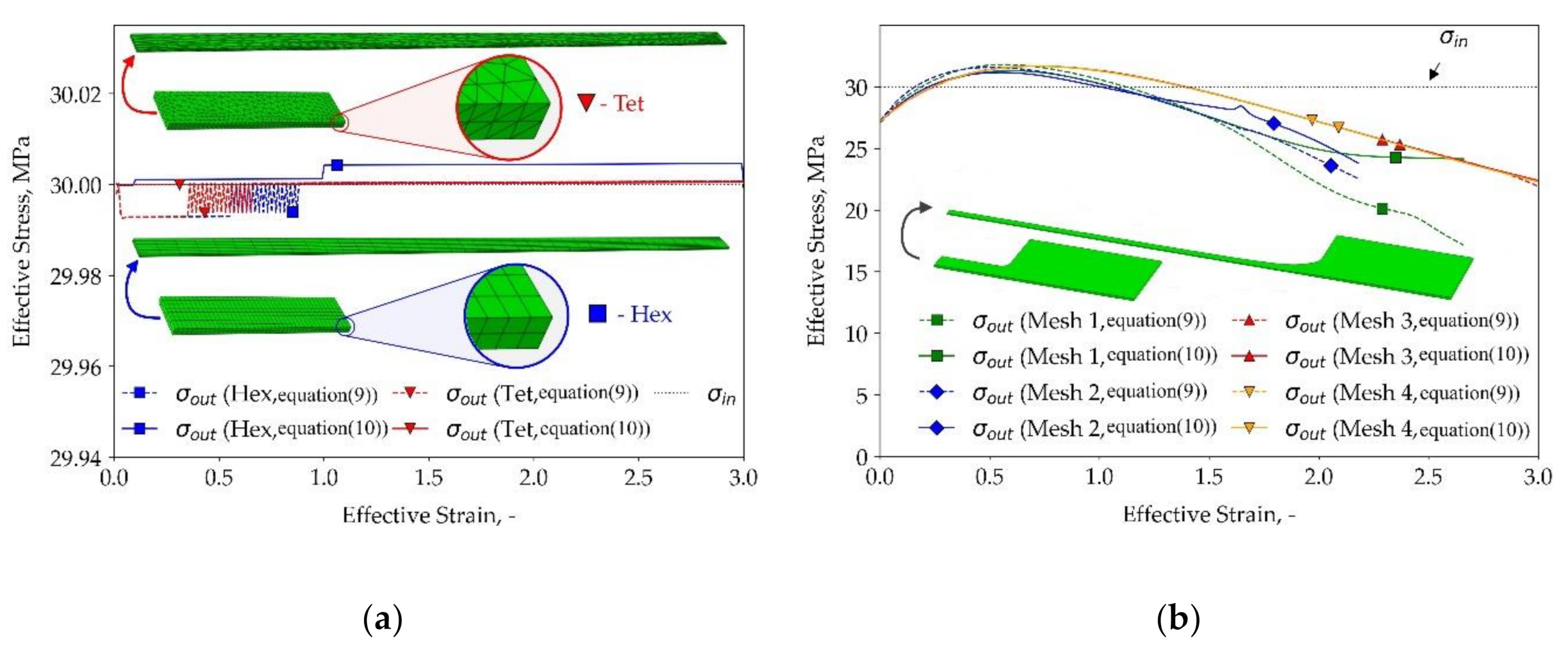


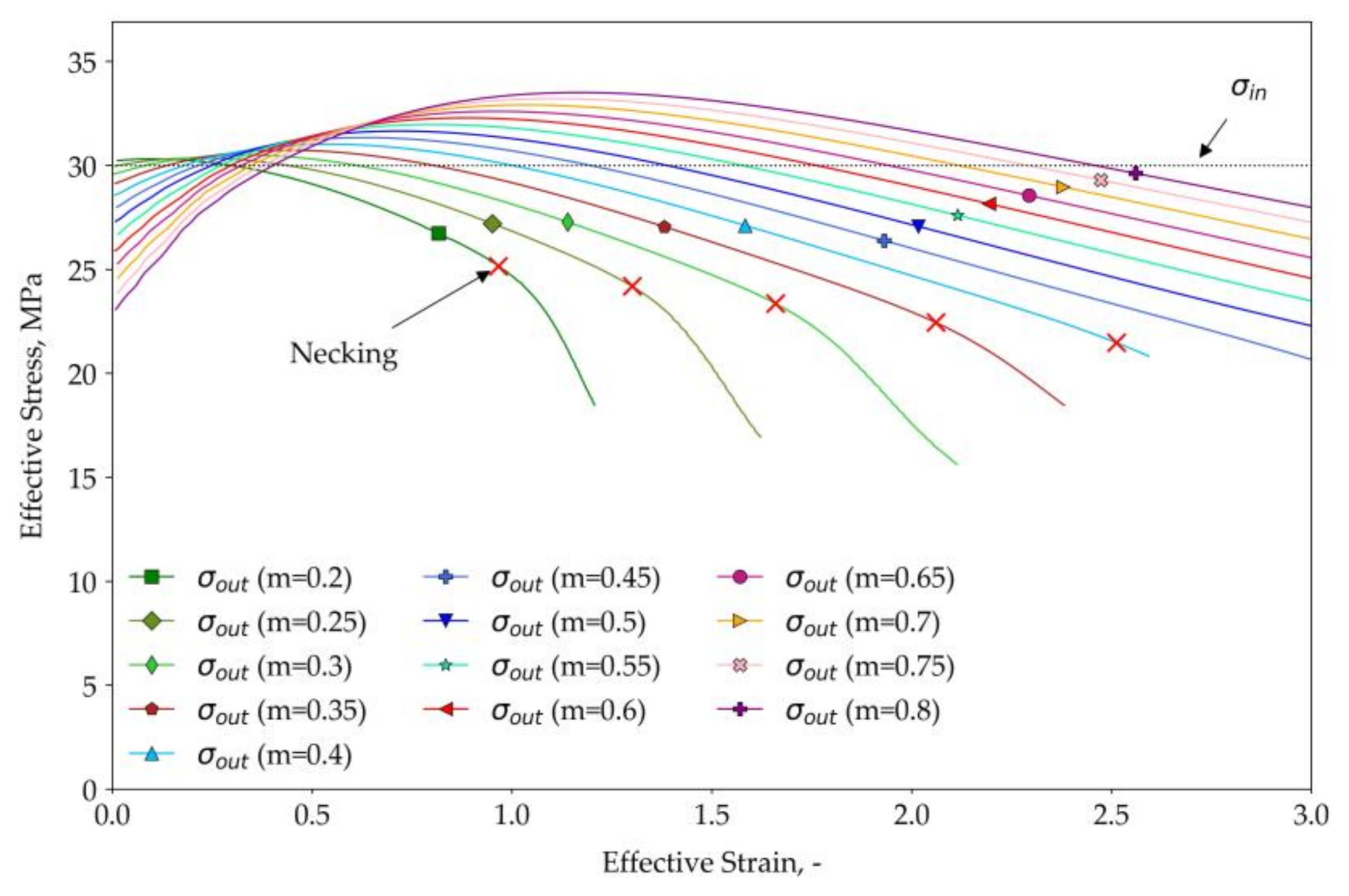
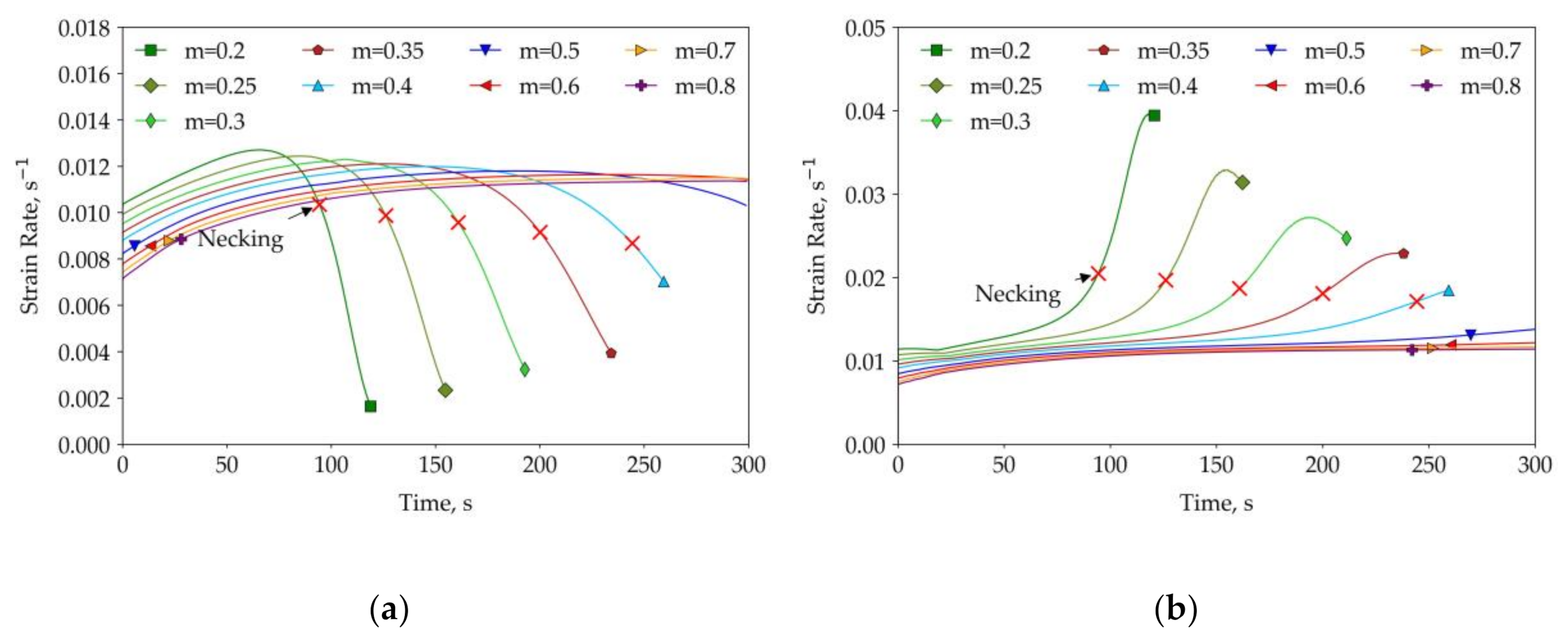

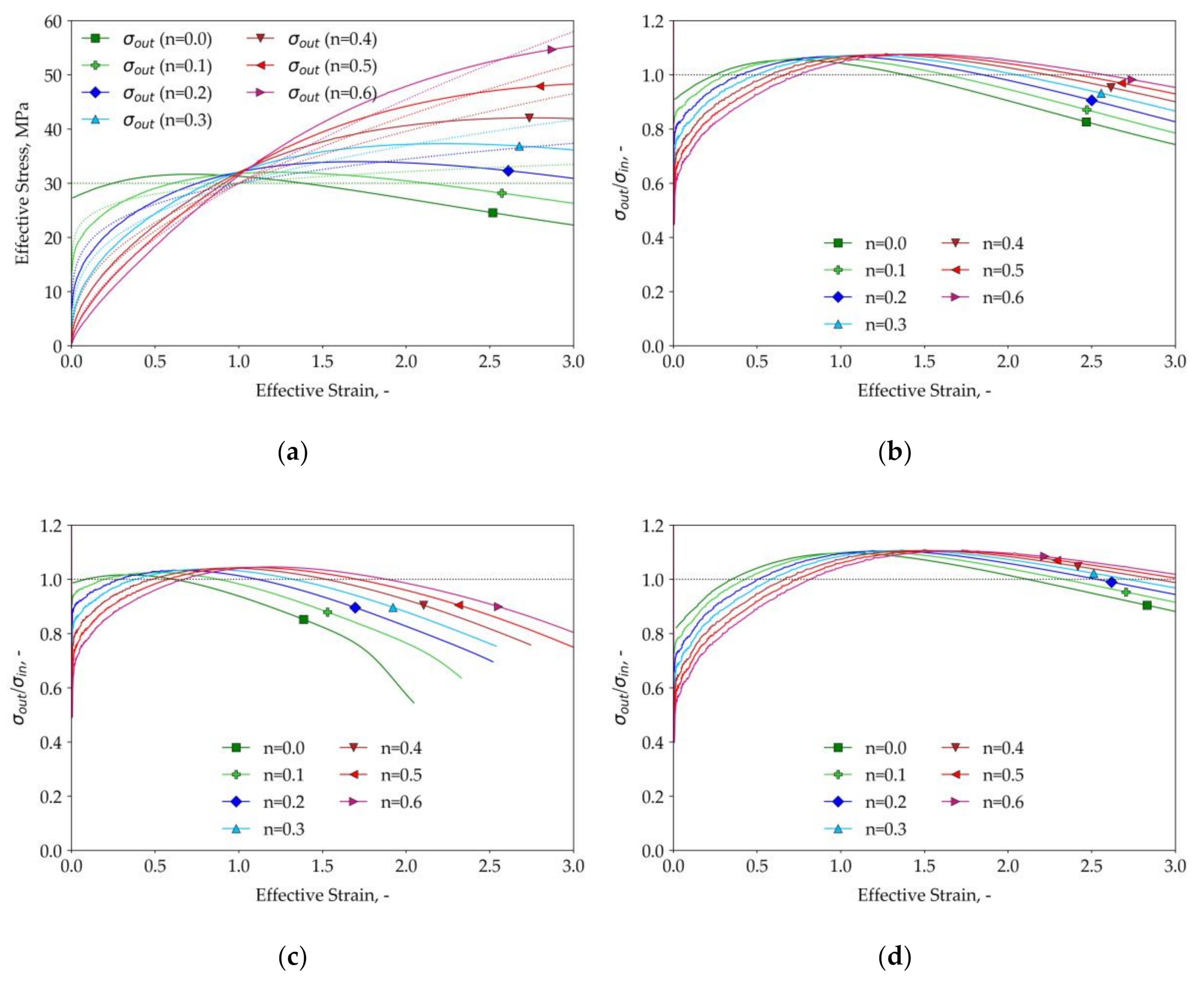
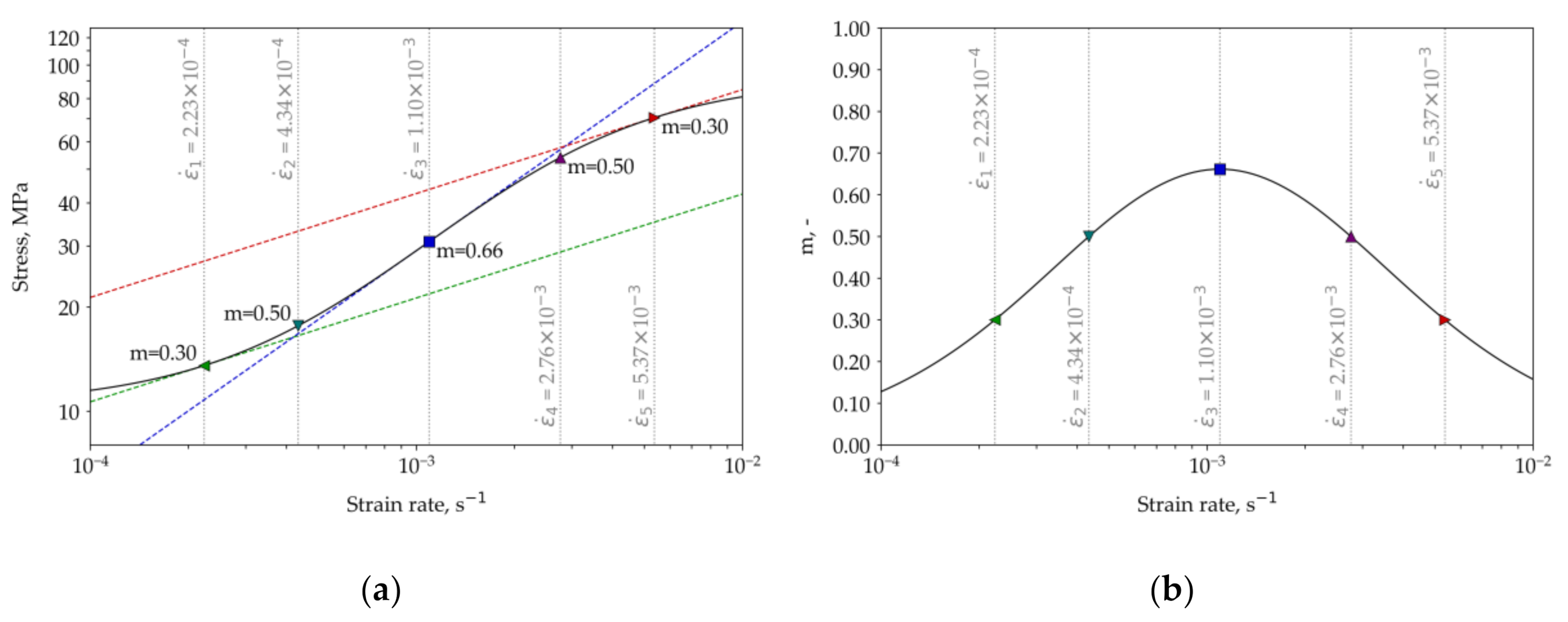
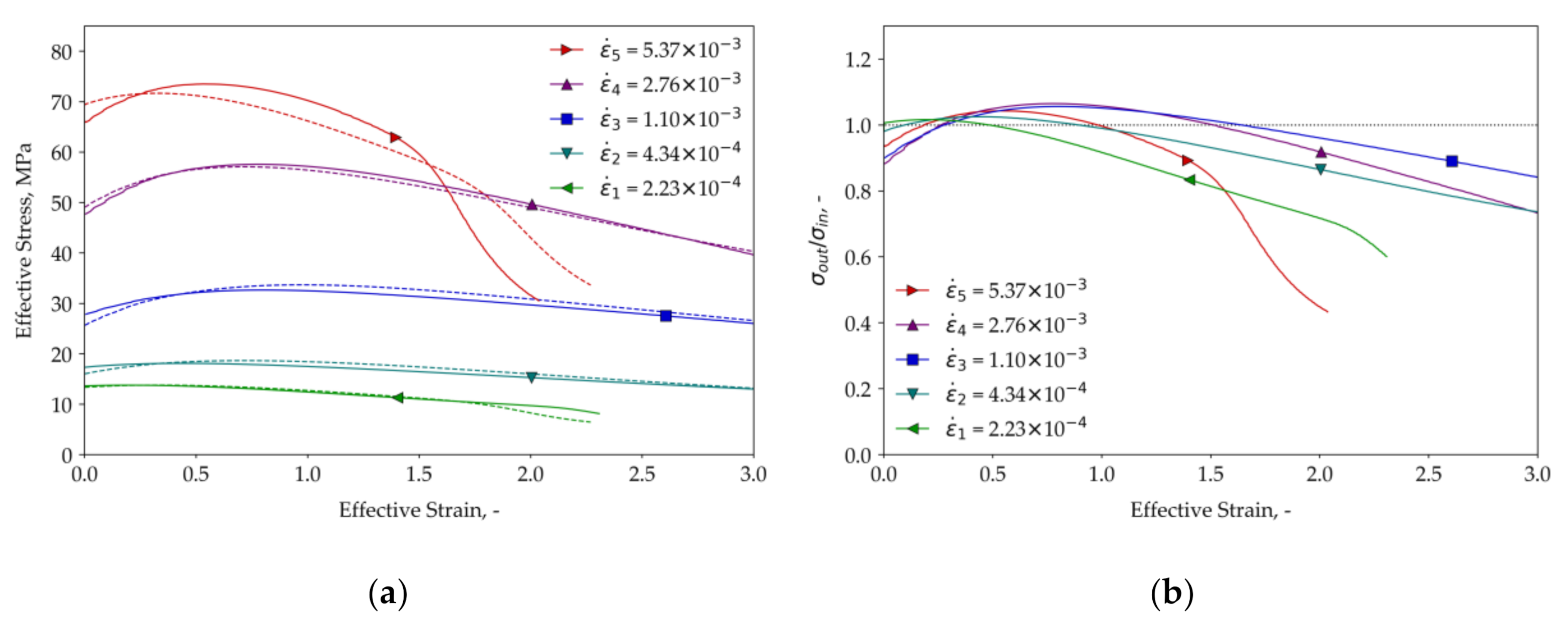
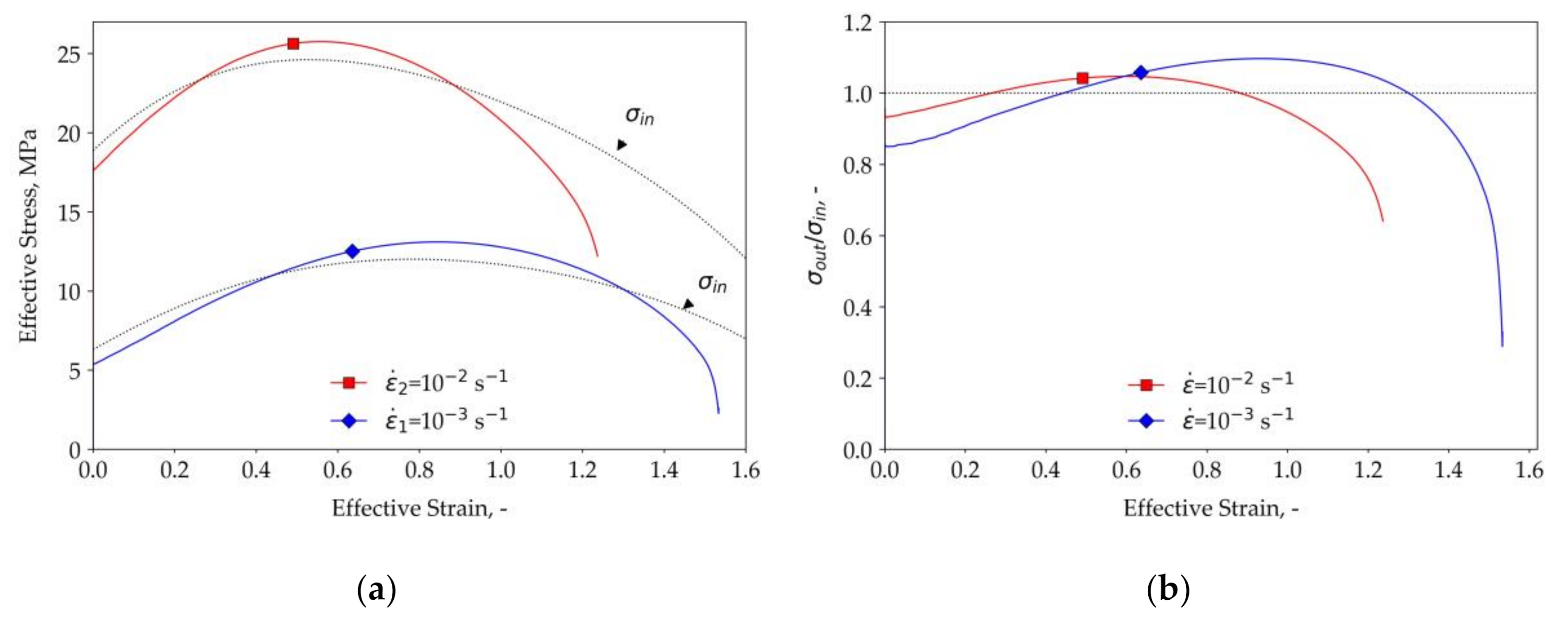


| Number | Initial Thickness | Friction Coefficient | Nominal Strain Rate | Deviation of the Output Stress | |
|---|---|---|---|---|---|
| 1 | 1 mm | 0.4 | 0.01 s−1 | 300 | reference test |
| 2 | 1 mm | 0.0 | 0.01 s−1 | 300 | 0.26% |
| 3 | 1 mm | 0.2 | 0.01 s−1 | 300 | 0.18% |
| 4 | 2 mm | 0.4 | 0.01 s−1 | 300 | 0.09% |
| 5 | 4 mm | 0.4 | 0.01 s−1 | 300 | 0.73% |
| 6 | 6 mm | 0.4 | 0.01 s−1 | 300 | 1.95% |
| 7 | 1 mm | 0.4 | 0.01 s−1 | 150 | 0.05% |
| 8 | 1 mm | 0.4 | 0.001 s−1 | 300 | 0.08% |
© 2020 by the authors. Licensee MDPI, Basel, Switzerland. This article is an open access article distributed under the terms and conditions of the Creative Commons Attribution (CC BY) license (http://creativecommons.org/licenses/by/4.0/).
Share and Cite
Aksenov, S.; Mikolaenko, V. The Effect of Material Properties on the Accuracy of Superplastic Tensile Test. Metals 2020, 10, 1353. https://doi.org/10.3390/met10101353
Aksenov S, Mikolaenko V. The Effect of Material Properties on the Accuracy of Superplastic Tensile Test. Metals. 2020; 10(10):1353. https://doi.org/10.3390/met10101353
Chicago/Turabian StyleAksenov, Sergey, and Vadim Mikolaenko. 2020. "The Effect of Material Properties on the Accuracy of Superplastic Tensile Test" Metals 10, no. 10: 1353. https://doi.org/10.3390/met10101353





